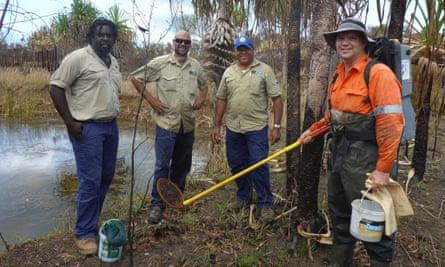An invasive fish species that can crawl across dry land, live up to six days out of water and suffocate its predators threatens to reach the Australian mainland after migrating south from Papua New Guinea.
The aggressive climbing perch has already been spotted on Australia’s two most northerly outposts, the Torres Strait islands of Boigu and Saibai, fewer than 10km south of the PNG mainland and 160km from Cape York, the northern tip of the Australian mainland.
A senior researcher in wetland ecology at James Cook University, Nathan Waltham, said the hardy fish would be a “major disaster” for certain native Australian fish species and other wetland dwellers, including turtles and birds.
The fish is native to south-east Asia and over the past four decades has spread south through Indonesia and PNG. It was first officially recorded on the two islands in 2006, having been washed over by heavy rainfall. Waltham said they will be very difficult to eradicate from the two islands.
The climbing perch, or Anabas testudineus, has sharp spines on the extendable cover of its gills, which it uses to drag itself over dry land as it travels from one waterhole to another.
Waltham said the fish was also able to survive for relatively long periods of time out of water because “next to the gills it has lungs, same as us, so it can breathe air on land”.

There was evidence that the freshwater fish, which have been known to hibernate in the mud of dried-up creek beds for up to six months, could tolerate exposure to saltwater. Waltham said he observed climbing perch living in very salty waterholes, equivalent to ocean water, on a trip to the two islands in December.
Although it was unlikely the fish would be capable of swimming to the Australian mainland there was a danger it would “arrive in the bottom of a fishing boat or as discarded live-bait fish”.
The scientists have brought the fish to their laboratory to better understand how much salt the fish can tolerate, how it is doing so and test how fast it can move across different terrain.
The fish has been known to swell up when swallowed by larger predators, blocking their throats so they choke or starve. Barramundi, catfish and even some aquatic birds that died after ingesting the fish have been discovered by Waltham’s colleagues in the PNG.
This unique ability worries Australian ecologists. “When they populate an area they’re not commonly found in, they can disrupt the balance of that habitat,” Waltham said. “That’s why we’re working with Torres Strait authorities to make sure they don’t spread further south.”
A team from James Cook University has been monitoring the perch’s spread with rangers from the Torres Strait regional authority and Torres Strait communities.
Waltham said locals that find a fish species they are not familiar with should report it to the relevant authorities. “Only with ongoing education and surveillance are we going to prevent climbing perch from arriving in northern Australia,” he said.
Herbert Warusam, a ranger on Saibai island, said the fish were being actively monitored and local fisherman were being educated to report sightings. “It is important we don’t let them travel beyond our island,” he said.
Waltham said the climbing perch was just one of several invasive wetland-dwelling species in PNG – including walking catfish, snakehead, pacu, tilapia and gourami – that posed a possible threat to Australian habitats.
Comments (…)
Sign in or create your Guardian account to join the discussion